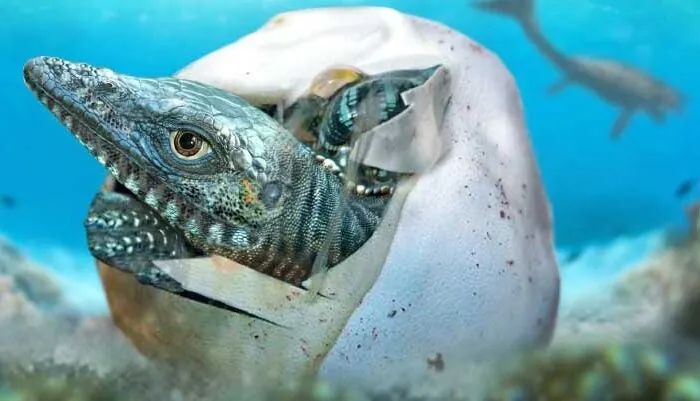
Unveiling the Shocking Truth About Ancient Marine Reptiles: A Game-Changing Fossil Discovery in Antarctica!
2025-05-25
Author: Arjun
A Groundbreaking Fossil Discovery in Antarctica
In a remarkable twist that has left scientists buzzing, a recent fossil find in Antarctica has transformed our understanding of ancient marine reptiles! Buried beneath layers of sediment for a staggering 68 million years, a football-sized soft-shelled egg, named Antarcticoolithus bradyi, has made history as the largest of its kind ever discovered—and the second-largest egg from any animal in Earth's past!
The Mystery Egg: More Than Just an Enigma
First unearthed by a Chilean research team in 2011 alongside the remains of a colossal marine reptile known as Kaikaifilu hervei, this peculiar egg left experts scratching their heads. Strikingly different from any known fossilized egg, its unique size and smooth texture earned it the nickname "The Thing," inspired by the chilling Antarctic sci-fi classic.
A Paleontological Puzzle: The Egg's Structure
Stretching approximately 11 inches long and 8 inches wide, A. bradyi's wrinkled and deflated appearance puzzled researchers. Julia Clarke, a vertebrate paleontologist at the University of Texas at Austin, explained the egg’s unusual features signify a groundbreaking find: There’s no known egg like this. It is exceptional in both size and structure. What’s truly intriguing is its ultra-thin shell, reminiscent of modern snakes and lizards, hinting that this egg was likely laid in water, paving the way for a marine birth.
A Paradigm Shift in Reproductive Beliefs
This revelation has sent shockwaves through the scientific community, forcing a reevaluation of how ancient marine reptiles reproduced. Previously thought to give live birth like some present-day species, A. bradyi suggests the possibility of soft-shelled eggs being significant in their reproductive cycles. Lucas Legendre, the lead researcher on the study, stated, "It is from an animal the size of a large dinosaur, but is completely unlike a dinosaur egg," indicating a more nuanced evolutionary history.
Could a Mosasaur Be the Parent?
While the egg contained no embryonic remains, its position near K. hervei leads researchers to theorize it may have belonged to a mosasaur, an aquatic reptile that ruled the oceans during the late Cretaceous period. Analysis of modern reptiles suggested this ancient creature likely measured at least 23 feet long, matching the size of nearby remains. In fact, the egg was discovered alongside baby mosasaurs and plesiosaurs, hinting that this area could have been a bustling nursery for marine reptiles!
Rethinking Reproductive Strategies
This find shakes up the long-held notion that mosasaurs gave birth to live young. Clarke remarks that this discovery shows their reproductive mode may have been similar to some modern lizards and snakes, allowing hatchlings to emerge almost immediately from their delicate shells.
The Elusive Nature of Soft-Shelled Eggs
Soft-shelled eggs like A. bradyi are incredibly rare in the fossil record due to their fragile nature, yet they offer invaluable insights into the reproduction of ancient reptiles. Studies have revealed that soft-shelled eggs existed in various prehistoric species, challenging the longstanding belief that all dinosaur eggs were hard-shelled.
How Were These Eggs Laid?
Debate continues around how A. bradyi was ultimately laid. One possibility is that, similar to modern sea snakes, mosasaurs laid their eggs in water for immediate hatching. Alternatively, they might have deposited them on beaches, allowing hatchlings to navigate their way to the sea, akin to baby turtles. However, the size of these massive creatures makes this scenario less likely.
Antarctica: A Treasure Trove for Paleontological Wonders
This fascinating discovery underscores Antarctica's vital role in unlocking the mysteries of our planet's past, with promising prospects for future finds. Clarke neatly summed it up: These fossils really change our thinking about the lifestyles of extinct animals. As researchers plan expeditions back to this icy frontier, the fossilized egg of A. bradyi could lead to critical revelations about the evolution of reptilian reproduction.
Join the excitement as we uncover the twists and turns of our planet's prehistoric narrative!



 Brasil (PT)
Brasil (PT)
 Canada (EN)
Canada (EN)
 Chile (ES)
Chile (ES)
 Česko (CS)
Česko (CS)
 대한민국 (KO)
대한민국 (KO)
 España (ES)
España (ES)
 France (FR)
France (FR)
 Hong Kong (EN)
Hong Kong (EN)
 Italia (IT)
Italia (IT)
 日本 (JA)
日本 (JA)
 Magyarország (HU)
Magyarország (HU)
 Norge (NO)
Norge (NO)
 Polska (PL)
Polska (PL)
 Schweiz (DE)
Schweiz (DE)
 Singapore (EN)
Singapore (EN)
 Sverige (SV)
Sverige (SV)
 Suomi (FI)
Suomi (FI)
 Türkiye (TR)
Türkiye (TR)
 الإمارات العربية المتحدة (AR)
الإمارات العربية المتحدة (AR)